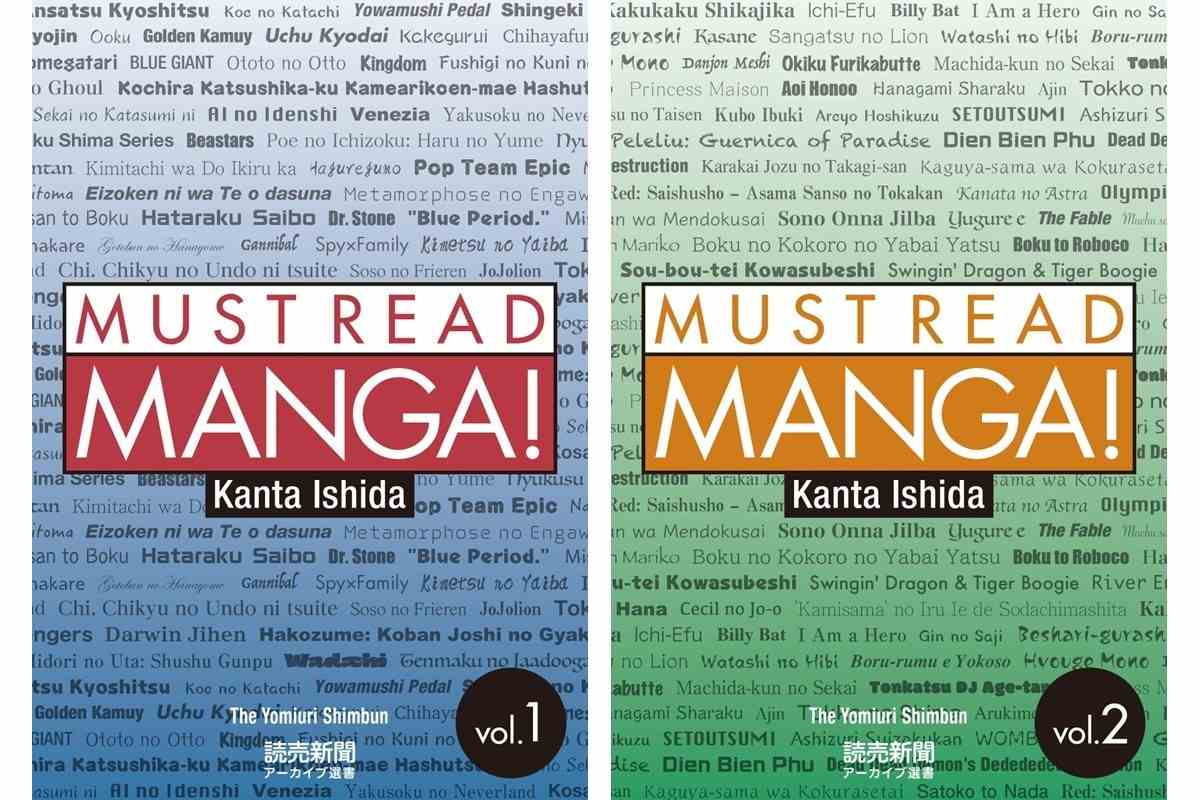
Left: “MUST READ MANGA! Vol.1”
Right: “MUST READ MANGA! Vol.2”
By Kanta Ishida
8:00 JST, April 16, 2024
A regular column of The Japan News that has been introducing to readers the best in contemporary manga has been published as two e-books — “Must Read Manga 1” and “Must Read Manga 2.” The collections of “Kanta on Manga” are available both in Japan and abroad.
Both volumes contain 50 selected manga reviews by Kanta Ishida, a veteran reporter of The Yomiuri Shimbun who is also the newspaper’s foremost manga authority. The column does not stop at simply introducing the stories. Sometimes it touches on the history of manga, and sometimes it connects a review to the current state of Japan and the world. By doing so, the column successfully depicts the current status of manga, which has grown into a culture that represents Japan.
Ishida is well-versed in manga, anime and other subculture genres. He is a hard-core manga otaku who has been reading manga for nearly 60 years. He selects only the works he can confidently recommend to readers and reviews them in the column, he said. In each review, he comprehensively explains the beauty of the work while also presenting discussions on manga as a medium.
One such discussion is about the definition of manga. Classic artworks, such as “Choju Jinbutsu Giga” (“Scrolls of Frolicking Animals”), which were drawn about 800 years ago, and comical pictures drawn by ukiyo-e artist Katsushika Hokusai in the Edo period (1603-1867) are sometimes called manga as well. In the introduction of “Must Read Manga,” Ishida writes that is by no means a mistake. He continues:
“However, in my opinion, the manga that has spread worldwide has its roots in basic art techniques brought to Japan by British and French artists who arrived during the Meiji era (1868-1912). After the Pacific War, this manga style became established with ‘Shin Takarajima’ (‘New Treasure Island,’ 1947) the debut work of Osamu Tezuka (1928-1989), who had been influenced by Disney films from the United States.
“In other words, manga has been multinational and culturally eclectic from its very outset, rather than an extension of traditional Japanese culture.”
The review that follows is persuasive and gives readers an eye-opening experience.
In the review on “JoJoLion” by Hirohiko Araki, Ishida wrote:
“This artistic inspiration has brought about a revolution in battle manga involving supernatural powers since the beginning of the Heisei era (1989-2019). In fact, it would not be an exaggeration to say that all recent hit manga in Shonen Jump magazine are basically under the influence of Araki.”
To back up his statement, Ishida referred to the concept of “Stands,” which was invented by Araki. Before this work, psychokinetic power and other supernatural energies were usually drawn as invisible phenomena in manga. “Stands” is a new form of expression, a way to visualize such energies. For example, a muscular warrior springs out from behind the protagonist and begins to beat up the enemy, shouting “Ora, ora, ora! ” (Hey, hey, hey!).

The cover of the first volume of “JoJolion” by Hirohiko Araki published by Shueisha Inc.
On the other hand, Ishida describes Kamado Tanjiro, the protagonist of “Kimetsu no Yaiba” (“Demon Slayer”) by Koyoharu Gotoge, as a non-Shonen Jump hero because of his kindness. Quoting Tanjiro’s line, “Strong people help and protect weaker people. The weaker become stronger, and they help and protect the even weaker ones. This is the law of nature,” Ishida wrote:
“Here I definitely sense an expression of a new value system that can resist and confront the 21st century value of ‘the survival of the fittest.’”

The cover of the first volume of “Kimetsu no Yaiba” (“Demon Slayer”) by Koyoharu Gotouge published by Shueisha Inc.
The two volumes of “Must Read Manga” not only review and analyze the works included but also show Ishida’s abundant love for Japan’s manga culture. Let me conclude this article by quoting his words in the introduction of the second volume.
“With the nation defeated, the postwar period in Japan began with atonement for what the country did to the international community. How would children overcome the wrongs committed by adults? How would they regain the pride that this country definitively lost?”
I believe that every manga of note incorporates these issues. Manga is meant to be a form of entertainment, but at the same time, it also transcends that.
"Culture" POPULAR ARTICLE
-

Van Cleef & Arpels Dazzles with Art Deco Artisanry at Tokyo Exhibit
-

Disney’s ‘Twisted-Wonderland’ Animated Series Puts Villains in Spotlight: New Show Features School Inspired by Classic Disney Films
-

Japan Plans to Distribute Manga Overseas Via New Platform
-

Japanese Craftsman Produces Beautiful and Durable Bags Made of Wood
-

Ayumi Hamasaki’s Shanghai Concert Canceled Day Before Schedule as Part of Beijing Backlash
JN ACCESS RANKING
-

Keidanren Chairman Yoshinobu Tsutsui Visits Kashiwazaki-Kariwa Nuclear Power Plant; Inspects New Emergency Safety System
-

Imports of Rare Earths from China Facing Delays, May Be Caused by Deterioration of Japan-China Relations
-

University of Tokyo Professor Discusses Japanese Economic Security in Interview Ahead of Forum
-

Japan Pulls out of Vietnam Nuclear Project, Complicating Hanoi’s Power Plans
-

Govt Aims to Expand NISA Program Lineup, Abolish Age Restriction






◎上海の日本アニメイベント_20251129YGTGS000921_C-250x168.jpg)




















